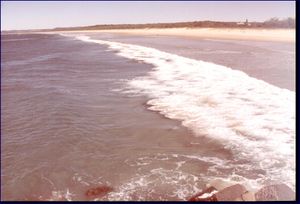Difference between revisions of "Coastal zone characteristics"
(→Muddy coasts) |
(→Muddy coasts) |
||
| Line 18: | Line 18: | ||
===Muddy coasts=== | ===Muddy coasts=== | ||
[[Image:mangrove coast.jpg|thumb|Fig. 2. Mangrove coast. Source: [http://www.dhigroup.com DHI]]] | [[Image:mangrove coast.jpg|thumb|Fig. 2. Mangrove coast. Source: [http://www.dhigroup.com DHI]]] | ||
| − | Muddy coasts are only found in environments that are fairly calm with respect to wave conditions; or there is abundant supply of fine sediments. They are normally vegetated e.g. [[mangroves]] fronted by very flat slopes/[[tidal flats]] or a muddy coast with mangrove vegetation which is characterized by a muddy shoreface, sometimes in the form of muddy tidal flats, and the lack of a sandy shore. | + | Muddy coasts are only found in environments that are fairly calm with respect to wave conditions; or there is abundant supply of fine sediments. They are normally vegetated e.g. [[mangroves]] fronted by very flat slopes/[[tidal flats]] or a muddy coast with [[mangrove]] vegetation which is characterized by a muddy shoreface, sometimes in the form of muddy [[tidal flats]], and the lack of a sandy shore. |
<u>'''Links'''</u>: | <u>'''Links'''</u>: | ||
Revision as of 11:25, 30 October 2007
This one should be relatively short - with links to more specific entries.
Contents
Different coastal types:
Sandy beaches

Sand is a very common marine sediment and is transported along the shoreline by littoral transport. Sand transport (littoral transport or littoral drift) is driven by the breaking waves and the longshore currents in the wave breaking zone. The appearance of a natural sandy beach is determined by hydrographic conditions and geology. Any interference will cause a reaction in the form of a shoreline response. Therefore, understanding of physical processes is important and the development of suitable solutions required, supported by numerical modelling if needed.
Links:
Muddy coasts

Muddy coasts are only found in environments that are fairly calm with respect to wave conditions; or there is abundant supply of fine sediments. They are normally vegetated e.g. mangroves fronted by very flat slopes/tidal flats or a muddy coast with mangrove vegetation which is characterized by a muddy shoreface, sometimes in the form of muddy tidal flats, and the lack of a sandy shore.
Links:
Rocky coasts
Rocky coasts are continuously cut back by the sea and are characterised by erosional features. They have a slow rate of morphological change, and experience the main erosional processes of: mechanical wave erosion, abrasion and hydraulic action; weathering - physical, salt, chemical and water-layer levelling; bio-erosion - biochecmial and biophysical; and mass movements by rock falls and toppling, slides and flows[1].
Arctic coasts
Shores above the North Polar Circle, exposed for more than six months of freezing annually are regarded as Arctic coast. Their characteristic feature is the importance of ice forms (glacial ice – growlers, sea ice – ice pack and winter local ice – ice foot) for their ecology and evolution. Ice act as a limiting factor for the occurrence of infaunal and epifaunal organisms (ice scouring, ice melt and freezing are all stressful processes for coastal macrofauna). Even in the high Arctic, macrofauna and macroalgae can survive winter ice in rocks crevices. In places, with very cold water, where permafrost surface at the intertidal, the specific type of Arctic shore appears – cryolittoral, where freshwater ice forms the seabed, often covered with stones and algal debris (northernmost parts of the Siberian coast and its islands). Soft sediment Arctic coasts are eroding very fast due to the combined effect of ice melt, ice scouring and waves action.
Barrier coasts

Barrier islands are parallel to the shore, separated from mainland by a lagoon. In a profile with a more gentle slope than the equilibrium profile, sediments will be moved onshore, as waves on the shoreface will primarily transport sand towards shore attempting to build up equilibrium profile. Waves lose their energy over the gentle shoreface and deposition occurs some distance from shoreline, eventually developing into a barrier island due to the cross-shore transport. Transport of sand by longshore transport will add to barrier formation, a combination of sand spit and barrier island processes, normally occurring under type 1 and 2 conditions.
Links:
- Barrier islands
- Slapton barrier beach case study, UK
- Origin and Genesis of coastal barriere systems. Case study from Rømø in the Danish Wadden Sea
See also
References
- Mangor, Karsten. 2004. “Shoreline Management Guidelines”. DHI Water and Environment, 294pg.
- ↑ Masselink, G and Hughes, M. 2003. Introduction to Coastal Processes and Geomorphology. Hodder Arnold.
